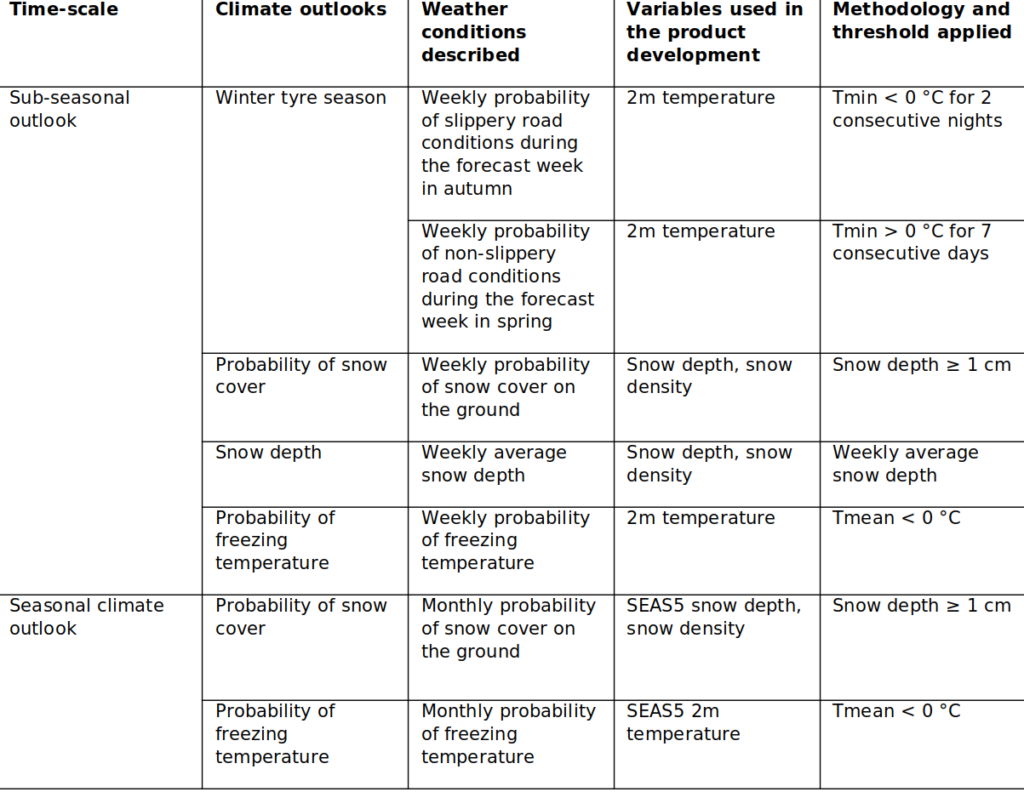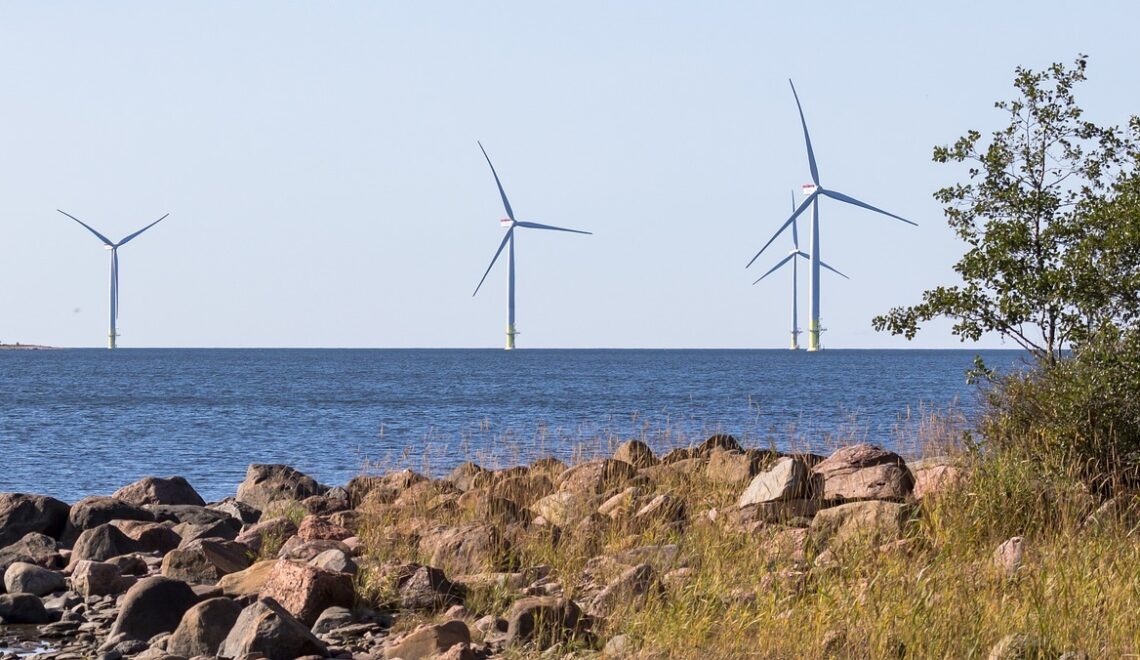In winter, driving safety is strongly weather dependent. Timely installation of winter tyres is essential when temperature falls to near 0 °C and the surface of the roads becomes slippery due to ice and snow. A new user-oriented climate service providing tailored sub-seasonal and seasonal climate outlooks for winter tyre season and safety driving conditions was developed and piloted by the Finnish Meteorological Institute and Vianor Oy.
ANDREA VAJDA, OTTO HYVÄRINEN, MIKA RANTANEN, ANDREAS TACK, MARKUS SILVENNOINEN
Finnish Meteorological Institute
According to the legislation, winter tyres must be used in Finland from 1 November to 31 March if the weather and road surface conditions require (Traficom 2020). Thus, the time of winter tyre installation and distribution to the customers varies from year to year in conformity with the weather conditions. In this paper, we present a new user-oriented climate service providing tailored sub-seasonal to seasonal predictions for tyre companies, developed within the H2020 e-shape project, Seasonal preparedness pilot. The service was co-created with the tyre and car service chain, Vianor Oy. The predictions provided via the sub-seasonal and seasonal climate outlooks for the upcoming six weeks and three months, respectively, allow tyre companies to plan the distribution of right tyre types, the seasonal management, and to provide relevant information for their customers about the time of tyre change. The climate service is currently in pilot phase, running in a fully automated operational mode.
Development of the sub-seasonal and seasonal climate outlooks. An iterative strategy was followed in the creation of climate outlooks. The end-user, Vianor, was engaged through dialog from the beginning of the design and development process to harmonize their needs in terms of forecast products, visualization and delivery method. Information about the skill of forecasts and uncertainties were also discussed. A set of sub-seasonal and seasonal forecast products (Table 1) relevant for winter driving safety were selected and designed with the user. For the onset and offset of winter tyre season outlook the thresholds for slippery conditions, hazarding driving safety, were determined based on literature survey and on analysis of road accident data from Finland (Finnish Crash Data Institute, OTI) against weather variables for the period 2005–2018.

Data from the state-of-the-art prediction systems from the European Centre for Medium-Range Weather Forecasts (ECMWF), i.e., sub-seasonal forecasts from the ensemble prediction system (EPS) (ECMWF 2016) and seasonal forecasts from SEAS5 system (Johnson et al. 2019) were used in the development and operational runs of the forecast products. The EPS data is produced for 46 days ahead twice a week, on Mondays and Thursdays, with 0.4° spatial resolution and is accessed through the ECMWF dissemination. SEAS5 system data is accessed from the Copernicus C3S Climate Data Store, where it is available with a horizontal resolution of 1° and updated on 13th of each month. The skill of variables used in the development of outlooks was assessed and systematic errors from the raw data was reduced through bias adjustment to improve the quality of the forecasts. The variables were evaluated and calibrated using re-forecast data for the period 2000–2019 and ERA5 reanalysis (Hersbach et al. 2020) as reference for the same period. The quality of the sub-seasonal variables was successfully improved by applying the mean bias removal method for 2m temperature and the quantile mapping method for snow depth (Fig. 1). In case of seasonal forecasts, the biases of 2m temperature and snow depth variables were reduced by ensemble model output statistics (EMOS) (Gneiting et al. 2005). All the variables were bias adjusted by the first pilot season (winter 2020–2021) except the sub-seasonal snow depth, which was adjusted by the start of the pilot season 2021–2022. After the post-processing of the input variables, the outlooks were computed. The winter tyre season, probability of snow cover and freezing temperature outlooks describe the likelihood of expected climate conditions through probability forecast, while the snow depth outlook predicts the absolute value of snow accumulation.

Production of sub-seasonal outlooks. The newly developed sub-seasonal outlooks are produced in operational runs on the FMI servers using the improved version of the operational service prototype developed in the CLIPS project (Ervasti et al. 2018) to produce sub-seasonal climate outlooks (clips.fmi.fi). The production run begins after the new forecast is disseminated to FMI. The variables extracted from the dissemination stream are post-processed and the climate outlooks are generated. The output data is visualized through weekly maps presenting the predicted weather conditions for each forecast product and disseminated to the users through an online user interface, the Ilmanet service platform (ilmanet.fi). The users can access the service using credentials. A user-friendly, easily understandable and interpretable format and easily accessible system were the main aspects when implementing the outlooks and the service. Each outlook consists of (1) an informational page including a short description of the forecast product and its definitions, information on the computation of the product and advice on how to interpret the forecast; (2) six static weekly maps presenting the predicted weather conditions either through probabilities or absolute values, and (3) animated version of the weekly maps (Fig. 2). The sub-seasonal outlooks are updated twice a week, on Tuesday and Friday. In September 2020, the first version of the service was set up and the winter tyre season outlook was released; the other outlooks were added in December 2020.

Production of seasonal climate outlooks. The seasonal climate outlooks are produced on WEkEO, a Copernicus DIAS services as soon as the updated seasonal forecast products from C3S CDS are shared on WEkEO. The forecast products are visualized through maps that are disseminated to the users through the seasonal.fmi.fi web-portal. The outlooks are updated on the 13th of each month. The production of seasonal climate outlooks was deployed in January 2021.
The first pilot season was run during winter 2020–2021, followed by a second pilot season during winter 2021–2022. After the first test season a preliminary qualitative evaluation of the forecast products was performed. Since the service wasn’t included yet to the workflow of the user during the first pilot season, their feedback on the forecast products will be received after the second pilot season. Based on the user’s feedback and the results of qualitative evaluation of the forecast products, the outlooks will be further improved to assure their usability.
This new climate service showcases the applicability of sub-seasonal and seasonal predictions tailored to support decision taking in transportation sector, allowing end-users to increase their preparedness and resilience to inter-annual climate variability.
Acknowledgements: The study contributes to the H2020 e-shape project (grant 820852) funded by the European Commission. The first version of the operational service prototype used in the production of sub-seasonal outlooks was developed in the SA CLIPS project (clips.fmi.fi) funded by the Academy of Finland (grant no. 303951). We thank the Finnish Crash Data Institute (OTI) for the road accident data provided.
References
ECMWF, 2016: IFS documentation, CY43R2, Part V: Ensemble Prediction System. 23 pp, https://www.ecmwf.int/sites/default/files/elibrary/2016/17118-part-v-ensemble-prediction-system.pdf.
Ervasti, T., H. Gregow, A. Vajda, T. K. Laurila, and A. Mäkelä, 2018: Mapping users’ expectations regarding extended-range forecasts. Adv. Sci. Res., 15, 99–106, https://doi.org/10.5194/asr-15-99-2018.
Finnish Transport and Communication Agency (TRAFICOM), 2020: Winter tyres. Accessed 6 September 2020, https://www.traficom.fi/en/transport/road/winter-tyres.
Gneiting, T., A. E. Raftery, A. H. Westveld III, and T. Goldman, 2005: Calibrated Probabilistic Forecasting Using Ensemble Model Output Statistics and Minimum CRPS Estimation. Mon. Wea. Rev., 133, 1098–1118, https://doi.org/10.1175/MWR2904.1.
Hersbach, H., and Coauthors, 2020: The ERA5 Global Reanalysis. Q. J. R. Meteorol. Soc., 146, 1999–2049, https://doi.org/10.1002/qj.3803.
Johnson, S. J., and Coauthors, 2019: SEAS5: The new ECMWF seasonal forecast system. Geosci. Model Dev., 12, 1087–1117, https://doi.org/10.5194/gmd-12-1087-2019.
HOW TO CITE THIS ARTICLE:
Vajda, A., O. Hyvärinen, M. Rantanen, A. Tack, and M. Silvennoinen, 2022: Seasonal preparedness pilot – sub-seasonal and seasonal service for tyre companies, FMI’s Clim. Bull. Res. Lett., 4(1), 5–7, https://doi.org/10.35614/ISSN-2341-6408-IK-2022-02-RL.
CITATION INFORMATION:
Authors: Andrea Vajda, Otto Hyvärinen, Mika Rantanen, Andreas Tack, Markus Silvennoinen
Received: November 29, 2021
Accepted: January 25, 2022
First online: February 03, 2022
Published: September 2, 2022
Journal: FMI’s Climate Bulletin Research Letters
Volume: 4
Issue: 1
Pages: 5–7
DOI: https://doi.org/10.35614/ISSN-2341-6408-IK-2022-02-RL
This article is part of the e-shape Special Issue.
Header image: Pixabay




